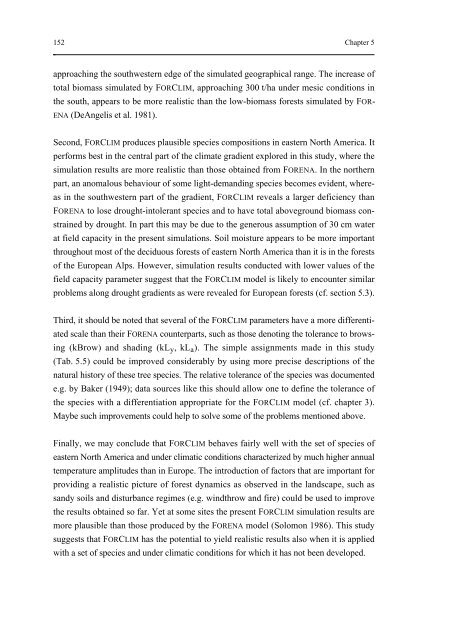On the Ecology of Mountainous Forests in a Changing Climate: A ...
On the Ecology of Mountainous Forests in a Changing Climate: A ...
On the Ecology of Mountainous Forests in a Changing Climate: A ...
Create successful ePaper yourself
Turn your PDF publications into a flip-book with our unique Google optimized e-Paper software.
152 Chapter 5<br />
approach<strong>in</strong>g <strong>the</strong> southwestern edge <strong>of</strong> <strong>the</strong> simulated geographical range. The <strong>in</strong>crease <strong>of</strong><br />
total biomass simulated by FORCLIM, approach<strong>in</strong>g 300 t/ha under mesic conditions <strong>in</strong><br />
<strong>the</strong> south, appears to be more realistic than <strong>the</strong> low-biomass forests simulated by FOR-<br />
ENA (DeAngelis et al. 1981).<br />
Second, FORCLIM produces plausible species compositions <strong>in</strong> eastern North America. It<br />
performs best <strong>in</strong> <strong>the</strong> central part <strong>of</strong> <strong>the</strong> climate gradient explored <strong>in</strong> this study, where <strong>the</strong><br />
simulation results are more realistic than those obta<strong>in</strong>ed from FORENA. In <strong>the</strong> nor<strong>the</strong>rn<br />
part, an anomalous behaviour <strong>of</strong> some light-demand<strong>in</strong>g species becomes evident, whereas<br />
<strong>in</strong> <strong>the</strong> southwestern part <strong>of</strong> <strong>the</strong> gradient, FORCLIM reveals a larger deficiency than<br />
FORENA to lose drought-<strong>in</strong>tolerant species and to have total aboveground biomass constra<strong>in</strong>ed<br />
by drought. In part this may be due to <strong>the</strong> generous assumption <strong>of</strong> 30 cm water<br />
at field capacity <strong>in</strong> <strong>the</strong> present simulations. Soil moisture appears to be more important<br />
throughout most <strong>of</strong> <strong>the</strong> deciduous forests <strong>of</strong> eastern North America than it is <strong>in</strong> <strong>the</strong> forests<br />
<strong>of</strong> <strong>the</strong> European Alps. However, simulation results conducted with lower values <strong>of</strong> <strong>the</strong><br />
field capacity parameter suggest that <strong>the</strong> FORCLIM model is likely to encounter similar<br />
problems along drought gradients as were revealed for European forests (cf. section 5.3).<br />
Third, it should be noted that several <strong>of</strong> <strong>the</strong> FORCLIM parameters have a more differentiated<br />
scale than <strong>the</strong>ir FORENA counterparts, such as those denot<strong>in</strong>g <strong>the</strong> tolerance to brows<strong>in</strong>g<br />
(kBrow) and shad<strong>in</strong>g (kL y , kL a ). The simple assignments made <strong>in</strong> this study<br />
(Tab. 5.5) could be improved considerably by us<strong>in</strong>g more precise descriptions <strong>of</strong> <strong>the</strong><br />
natural history <strong>of</strong> <strong>the</strong>se tree species. The relative tolerance <strong>of</strong> <strong>the</strong> species was documented<br />
e.g. by Baker (1949); data sources like this should allow one to def<strong>in</strong>e <strong>the</strong> tolerance <strong>of</strong><br />
<strong>the</strong> species with a differentiation appropriate for <strong>the</strong> FORCLIM model (cf. chapter 3).<br />
Maybe such improvements could help to solve some <strong>of</strong> <strong>the</strong> problems mentioned above.<br />
F<strong>in</strong>ally, we may conclude that FORCLIM behaves fairly well with <strong>the</strong> set <strong>of</strong> species <strong>of</strong><br />
eastern North America and under climatic conditions characterized by much higher annual<br />
temperature amplitudes than <strong>in</strong> Europe. The <strong>in</strong>troduction <strong>of</strong> factors that are important for<br />
provid<strong>in</strong>g a realistic picture <strong>of</strong> forest dynamics as observed <strong>in</strong> <strong>the</strong> landscape, such as<br />
sandy soils and disturbance regimes (e.g. w<strong>in</strong>dthrow and fire) could be used to improve<br />
<strong>the</strong> results obta<strong>in</strong>ed so far. Yet at some sites <strong>the</strong> present FORCLIM simulation results are<br />
more plausible than those produced by <strong>the</strong> FORENA model (Solomon 1986). This study<br />
suggests that FORCLIM has <strong>the</strong> potential to yield realistic results also when it is applied<br />
with a set <strong>of</strong> species and under climatic conditions for which it has not been developed.















